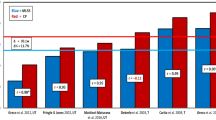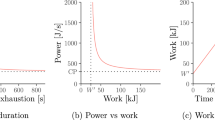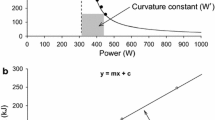Abstract
It is well established that for work requiring high power output, endurance time is short, and that low power outputs can be maintained for long periods. Parameters describing this relationship are important in characterising work performance and the capacity of humans as a source of mechanical power. The purpose of this paper is to provide a brief review of the available literature investigating this relationship and its parameters. Most experimental data reflect measurements of endurance times over a range of constant power outputs on the cycle ergometer. Early graphical analyses of these data have been superseded by curve fitting, which in turn has led to establishment of the two component hyperbolic model now embodied in the critical power test. This model has been modified and extended in various ways to account for its shortcomings. In addition, a number of different exercise forms have been studied, and the effects of a variety of secondary factors (training status, age, sex, for example) on the parameters have also been investigated.
Similar content being viewed by others
References
Aunola S, Alanen E, Marniemi J (1990) The relation between cycling time to exhaustion and anaerobic threshold. Ergonomics 33:1027–1042
Bellemare F, Grassino A (1982) Effect of pressure and timing of contraction on human diaphram fatigue. J Appl Physiol 53:1190–1195
Biggerstaff KD, Hill DW, Jackson SL, Sams BR (1992) Use of the critical power concept to evaluate anaerobic capacity in swimmers. Med Sci Sports Exerc 24:74
Bigland-Ritchie B, Woods JJ (1984) Changes in muscle contractile properties and neural control during human muscular fatigue. Muscle Nerve 7:691–699
Bishop D, Jenkins DG (1996) The influence of recovery duration between exercise bouts on the critical power function. Eur J Applied Physiol (in press)
Bulbulian R, Wilcox AR, Darabos BL (1989) Anaerobic contribution to distance running performance of trained cross-country athletes. Med Sci Sports Exerc 18:107–113
Carlson RB (1969) Level of maximum isometric strength and relative load isometric endurance. Ergonomics 12:429–435
Carlson RB, McCraw LW (1971) Isometric strength and relative isometric endurance. Res Q 42:244–250
Carnevale TJ, Gaesser GA (1991) Effects of pedaling speed on the power-duration relationship for high-intensity exercise. Med Sci Sports Exerc 23:242–246
Clarke DH (1986) Sex differences in strength and fatigability. Res Q Exer Sport 57:114–149
Clingeleffer A, McNaughton L, Davoren B (1994) Critical power may be determined from two tests in elite kayakers. Eur J Appl Physiol 68:36–40
DeVries HA, Moritani T, Nagata A, Magnussen K (1982) The relation between critical power and neuromuscular fatigue as estimated from electromyographic data. Ergonomics 25:783–791
DeVries HA, Tichy MW, Housh TJ, Smyth KD, Tichy AM (1987) Method for estimating physical working capacity at the fatigue threshold (PWCFT). Ergonomics 30:1195–1204
Ettema JH (1966) Limits of human performance and energy-production. Int Z Angew Physiol Einschl Arbeitphysiol 22:45–54
Gaesser GA, Wilson LA (1988) Effects of continuous and interval training on the parameters of the power-endurance time relationship for high-intensity exercise. Int J Sports Med 9:417–421
Gaesser GA, Carnevale TJ, Garfinkel A, Walter DO (1990) Modeling of the power-endurance relationship for high-intensity exercise. Med Sci Sports Exerc 22:S16
Ginn EM, MacKinnon LT (1989) The equivalance of onset of blood lactate accumulation, critical power and maximal lactate steady state during kayak ergometry. Proceedings of the first International Olympic Committee (IOC) World Congress on Sports Sciences 34
Gleser MA, Vogel JA (1973) Endurance capacity for prolonged exercise on the bicycle ergometer. J Appl Physiol 34:438–442
Green HJ, Hughson RL, Orr GW, Rawney DA (1983) Anaerobic threshold, blood lactate and muscle metabolites in progressive exercise. J Appl Physiol 54:1032–1038
Green S, Dawson B (1993) Measurement of anaerobic capacities in humans. Sports Med 15:312–327
Green S, Dawson BT, Goodman C, Carey MF (1994) Y-Intercept of the maximal work-duration relationship and anaerobic capacity in cyclists. Eur J Appl Physiol 69:550–556
Grosse-Lordeman H, Miller EA (1973) Der Einfluss der Leistung und der Arbeitsgeschwindikeit auf dasrbeits maximum und den Wirkungsgrad beim Radfahren. Arbeits Physiol 9:454–475
Harmann NEA, Knuttgen HG, Frykman PN, Patton J (1987) Exercise endurance time as a function of percent maximal power production. Med Sci Sports Exerc 19:480–485
Heyward VH (1975) Influence of statistic strength and intermuscular occlusion on submaximal static muscle endurance. Res Q 46:393–402
Hill DW (1993) The critical power concept. Sports Med 16:237–254
Hill DW, Rose LE, Smith JC (1993) Estimates of anaerobic capacity derived using different models of the power-time relationship. Med Sci Sports Exerc 25:S108
Hill DW, Smith JC, Hasteen SD, Leuschel JL, Miller SA (1994) Methodological considerations in estimation of parameters of the power-time relationship. Med Sci Sports Exerc 26:S44
Hopkins WG, Edmond IM, Hamilton BH, MacFarlane DJ, Ross BH (1989) Relation between power and endurance for treadmill running of short duration. Ergonomics 32:1565–1571
Housh DJ, Housh TJ, Bange SM (1989) The accuracy of the critical power test for predicting time to exhaustion during cycle ergometry. Ergonomics 32:997–1004
Housh DJ, Housh TJ, Bauge SM (1990) A methodological consideration for the determination of critical power and anaerobic work capacity. Res Q Exerc Sport 61:406–409
Housh TJ, DeVries HA, Housh DJ, Tichy MW, Smyth KD, Tichy AM (1991) The relationship between critical power and the onset of blood lactate accumulation. J Sports Med Phys Fitness 31:31–36
Housh TJ, Johnson GO, McDowell SL, Housh DJ, Pepper M (1991) Physiological responses at the fatigue threshold. Int J Sports Med 12:305–308
Housh TJ, Johnson GO, McDowell SL, Housh DJ, Pepper ML (1992) The relationship between anaerobic running capacity and peak plasma lactate. J Sports Med Phys Fitness 32:117–122
Hughson RL, Kowalchuck JM (1995) Kinetics of oxygen uptake for submaximal exercise in hyperoxia, normoxia and hypoxia. Can J Appl Physiol 20:198–210
Hughson RL, Orok CJ, Staudt LE (1984) A high velocity treadmill running test to assess endurance running potential. Int J Sports Med 5:23–25
Hughson RL, Sherrill DL, Swanson GD (1988) Kinetics of VO2 with impulse and step exercise in man. J Appl Physiol 64:451–459
Jenkins DG, Quigley BM (1990) Blood lactate in trained cyclists during cycle ergometry at critical power. Eur J Appl Physiol 61:278–283
Jenkins DG, Quigley BM (1991) They y-intercept of the critical power function as a measure of anaerobic work capacity. Ergonomics 34:13–22
Jenkins DG, Quigley BM (1992) Endurance training enhances critical power. Med Sci Sports Exerc 24:1283–1289
Jenkins DG, Quigley BM (1993) The influence of high-intensity exercise training on the Wlim-Tlim relationship. Med Sci Sports Exerc 25:275–282
Johnson G, Housh T, McDowell S, Housh D, Pepper M (1990) Validity of a treadmill test of anaerobic capacity. Med Sci Sports Exerc 22:S16
Kennelly AE (1906) An approximate law of fatigue in the speeds of racing animals. Proc Am Acad Arts Sci XLII:275–331
Knuttgen HG (1986) Human performance in high-intensity exercise with concentric and eccentric muscle contractions. Int J Sports Med 7:6–9
Knuttgen HG, Patton JF, Vogel JA (1982) An ergometer for concentric and eccentric muscular exercise. J Appl Physiol 53:784–788
Kolbe T, Dennis SC, Selley E, Noakes TD, Lambert MI (1995) The relationship between critical power and running performance. J Sports Sci 13:265–269
Lane CJ, Steward RP, Hill DW (1994) Estimation of anaerobic capacity in swimmers using the critical power concept. Med Science Sports Exerc 25:S44
Maughan RJ, Harmon M, Leiper JB, Sale D, Delman A (1986) Endurance capacity of untrained males and females in isometric and dynamic muscular contractions. Eur J Appl Physiol 55:395–400
Mayhew JL, Ball TE, Bowen JC (1992) Prediction of bench press lifting ability from submaximal repetitions before and after training. Sports Med Train Rehabil 3:195–201
McDermott KS, Forbes MR, Hill DW (1993) Application of the critical power concept to outdoor running. Med Sci Sports Exerc 25:S109
McLellan TM (1987) The anaerobic threshold: concept and controversy. Aust J Sci Med Sports 19:3–8
McLellan TM, Cheung KSY (1992) A comparative evaluation of the individual anaerobic threshold and the critical power. Med Sci Sports Exerc 24:543–550
McLellan TM, Skinner JS (1985) Submaximal endurance performance related to the ventilation thresholds. Can J Appl Sports Sci 10:81–87
McLellan TM, Cheung SS, Jacobs I (1995) Variability of time to exhausion during submaximal exercise. Can J Appl Physiol 20:39–51
Medbo JI, Mohn AC, Tabata I, Bahr R, Vaage O, Sejersted OM (1988) Anaerobic capacity determined by maximal accumulated O2 deficit. J Appl Physiol 64:50–60
Monod H, Scherrer J (1965) The work capacity of a synergic muscular group. Ergonomics 8:329–338
Moritani T, Nagata A, DeVries HA, Muro M (1981) Critical power as a measure of physical work capacity and anaerobic threshold. Ergonomics 24:339–350
Morton RH (1986) A three component model of human bioenergetics. J Math Biol 24:451–466
Morton RH (1987) A simple model to link hemodynamics, fatigue and endurance in static work. J Biomech 20:641–644
Morton RH (1990) Modelling human power and endurance. J Math Biol 28:49–64
Morton RH (1994) The 3-parameter critical power model. School of Mathematical and Information Sciences Preprint Series, Massey University 94/5
Morton RH (1996) A 3-parameter critical power model. Ergonomics (in press)
Nadel ER, Pierce JB (1988) The Daedalus project: overcoming the physiological limits of human-powered flight. Med Sci Sports Exerc 20:S84
Nagata A, Moritani T, Muro M (1983) Critical power as a measure of muscular fatigue threshold and anaerobic threshold. In: Matsui H (ed) Kafayassi Conference Proceedings. Biomechanics VIII. Human Kinetics, Champaign, Ill., pp 312–320
Nebelsick-Gullett LJ, Housh TJ, Johnson GO, Bange SM (1988) A comparison between methods of measuring anaerobic work capacity. Ergonomics 31:1413–1419
Overend TJ, Cunningham DA, Paterson DH, Smith WDF (1992) Physiological responses of young and elderly men to prolonged exercise at critical power. Eur J Appl Physiol 64:187–193
Park SR, Rodbard S (1962) Effects of load and duration of tension on pain induced by muscular contraction. Am J Physiol 203:735–738
Pavlat DJ, Housh TJ, Johnson GO, Schmidt RJ, Eckerson JM (1993) An examination of the electromyographic fatigue threshold test. Eur J Appl Physiol 67:305–308
Pepper ML, Housh TJ, Johnson GO (1992) The accuracy of the critical velocity test for predicting time to exhaustion during treadmill running. Int J Sports Med 13:121–124
Pérronet F, Thibault G (1987) Analyse physiologique de la performance en course a pied: revision du model hyperbolique. J Physiol (Paris) 82:52–60
Péronnet F, Thibault G (1989) Mathematical analysis of running performance and world running records. J Appl Physiol 67:453–465
Péronnet F, Thibault G, Rhodes EC, McKenzie DC (1987) Correlation between ventilatory threshold and endurance capability in marathon runners. Med Sci Sports Exerc 19:610–615
Petrofsky IS, Phillips CA (1982) The strength-endurance relationship in skeletal muscle: its application to helmet design. Aviat Space Environ Med 53:365–369
Phillips CA, Petrofsky JS (1986) A computer model of neck muscle endurance and fatigue as a function of helmet loading. Comput Biol Med 16:103–130
Poole DC, Ward SA, Ward BJ (1986) Effects of training on the metabolic and respiratory profile of high-intensity exercise. Physiologist 29:161
Poole DC, Ward SA, Gardner GW, Whipp BJ (1988) Metabolic and respiratory profile of the upper limit for prolonged exercise in man. Ergonomics 31:1265–1279
Poole DC, Ward SA, Whipp BJ (1990) The effects of training on the metabolic and respiratory profile of high-intensity cycle ergometer exercise. Eur J Appl Physiol 59:421–429
Rodbard S, Bekay-Pragua E (1968) Contraction frequency, blood supply and muscle pain. J Appl Physiol 24:142–147
Rohmert W (1960) Ermittlung von erholungspausen für statische arbeit des menschen. Int Z Angew Physiol Einschl Arbeitsphysiol 18:123–164
Royce J (1958) Isometric fatigue curves in human muscle with normal and occluded circulation. Res Q 29:204–212
Saltin B, Karlsson J (1971) Muscle glycogen utilisation during work of different intensities. In: Pernow B, Saltin B (eds) Muscle metabolism during exercise. Plenum, New York, pp 289–300
Scarborough PA, Smith JC, Talbert SM, Hill DW (1991) Time to exhaustion at the power asymptote (critical power) in men and women. Med Sci Sports Exerc 23:S12
Sid-Ali B, Vandewalle H, Chair K, Moreaux A, Monod H (1991) Lactate steady state velocity and distance-exhaustion time relationship in running. Arch Int Physiol Biochem Biophys 99:297–301
Simonson E, Lind AR (1971) Fatigue in static work. In: Simonson E (ed) Physiology of work capacity and fatigue. Thomas Springfield, Ill., pp 241–283
Smith JC, Hill DW (1992) Mathematical models of the power-time relationship in high intensity cycling. Med Sci Sports Exerc 24:S74
Smith JC, Hill DW, Talbert SM (1991) Prediction of the power asymptote in men and women: role of repeated testing. Med Sci Sports Exerc 23:512
Stegemann J (1981) Work capacity and fatigue during static work. George Thieme, New York
Steward RP, Lane CJ, Hill DW (1994) Application of the critical power concept to young swimmers. Med Sci Sports Exerc 26:S44
Stokes DG, Schwanawede TW, Womack CJ, Weltman A (1993) Effects of strength training on the lactate threshold and parameters of the power-endurance hyperbola. Med Sci Sports Exerc 25:S163
Swanson GD, Holland RA, Van Walleghem EB (1992) Effect of prior leg exercise on high-intensity arm ergometry. Physiologist 35:199
Talbert SM, Smith JC, Scarborough PA, Hill DW (1991) Relationships between the power asymptote and indices of anaerobic and aerobic power. Med Sci Sports Exerc 23:527
Tuttle WW, Janney CD, Salzano JV (1955) Relation of maximum back and leg strength to back and leg strength endurance. Res Q 26:96–106
Vandewalle H, Peres G, Monod H (1987) Standard anaerobic exercise tests. Sports Med 4:268–289
Vandewalle H, Kapitaniak B, Grin S, Raveneau S, Monod H (1989) Comparison between a 30-s all-out test and a time-work test on a cycle ergometer. Eur J Appl Physiol 58:375–381
Wakayoshi K, Ikuta K, Yoshida T, Udo M, Moritani T, Mutoh Y, Miyashita M (1992a) Determination and validity of critical velocity as an index of swimming performance in the competitive swimmer. Eur J Appl Physiol 64:153–157
Wakayoshi K, Yoshida T, Udo M, Kasai T, Moritani T, Mutoh Y, Miyashita M (1992b) A, simple method for determining critical speed as swimming fatigue threshold in competitive swimming. Int J Sports Med 13:367–371
Wakayoshi K, Yoshida T, Moritani T (1993a) Does critical swimming velocity represent exercise intensity at maximal lactate steady state? Med Sci Sports Exerc 25:S66
Wakayoshi K, Yoshida T, Udo M, Harada T, Moritani T, Mutoh Y, Miyashita M (1993b) Does critical swimming velocity represent exercise intensity at maximal lactate steady state? Eur J Appl Physiol 66:90–95
Walsh ML, Banister WE (1988) Possible mechanisms of the anaerobic threshold: a review. Sports Med 5:269–302
Whipp BJ, Huntsman DJ, Storer TW, Lamarra N, Wasserman K (1982) A constant which determines the duration of tolerance to high-intensity work. Fed Proc 41:1591
Wilkie DR (1960) Man as a source of mechanical power. Ergonomics 3:1–8
Wilkie DR (1980) Equations describing power input by humans as a function of duration of exercise. In: Cerretelli P, Whipp BJ (eds) Exercise bioenergetics and gas exchange. Elsevier/North Holland Biomedical, Amsterdam, pp 75–80
Wilkie DR (1981) Shortage of chemical fuel as a cause of fatigue: studies by nuclear magnetic resonance and bicycle ergometry. In: Porter R, Whelan J (eds) Human muscle fatigue: Physiological mechanisms. Pitman Medical, London, pp 102–119
Author information
Authors and Affiliations
Rights and permissions
About this article
Cite this article
Morton, R.H., Hodgson, D.J. The relationship between power output and endurance: a brief review. Eur J Appl Physiol 73, 491–502 (1996). https://doi.org/10.1007/BF00357670
Accepted:
Issue Date:
DOI: https://doi.org/10.1007/BF00357670




